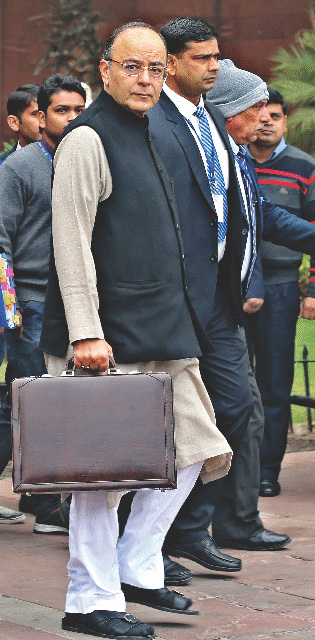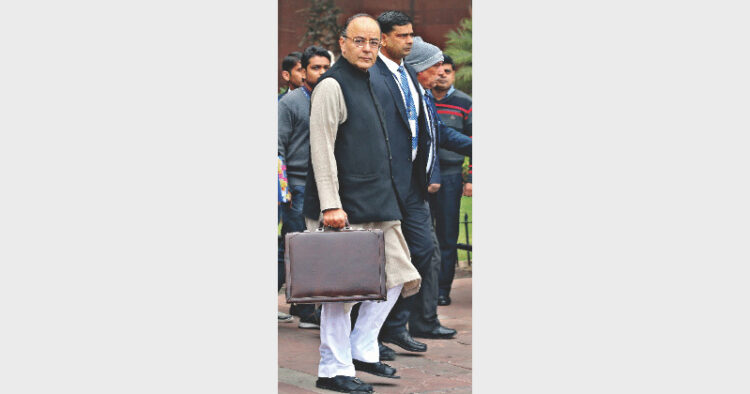 ‘Sabka Saath, Sabka Vikas’ has been the BJP’s slogan and ‘Bharatiyata’ is the core ideology. Since 2014, every year’s budget is following walk the talk policy for ensuring transparency and inclusive growth in economic governance without electoral considerations
‘Sabka Saath, Sabka Vikas’ has been the BJP’s slogan and ‘Bharatiyata’ is the core ideology. Since 2014, every year’s budget is following walk the talk policy for ensuring transparency and inclusive growth in economic governance without electoral considerations
JP Dubey
BJP takes pride in being called a party with a difference. It can now take pride in this budget — coming with a difference. Not just because it has been presented on the first day of February, nor that it has done away with the bifurcation of plan and non plan expenditure or that Rail budget has also been merged in it, but because it heralds a major change. Coming after audacious demonetisation which had taken everybody by surprise on November 8 and pulled through, thanks to immense trust the Prime Minister enjoys with the vast majority of the people of this country, this budget puts us on the path that may change our destiny beyond recognition, hopefully in foreseeable future.
Union Budget 2017-18 : Addressing Aspirations
Media routinely highlights the changes in income tax slabs and rates as if that is the most important thing in a budget but which affects only the tax payers whose number is so small in our country only 1.9 crores and falling. At present only 7 out of 100 voters pay tax that too after taking advantage of all concessions and loopholes. That percentage is 100 for Norway or about 60 for USA. We hope that after a few years that becomes a really very important part, if this government succeeds in widening the tax net and majority of 26-27 crore households becoming willing and well off taxpayers. Right now, however, cutting down the rate to 5 per cent over the first slab of 2.5 lakh to 5 lakh, is just one of the many points in this budget. Two points must however be noted. Direct taxes now constitute 52 per cent of the total tax revenue and personal income tax has grown at 25 per cent, much faster than
others. With Demonetisation effect the number of tax payers and collections are likely to go up. But the effect of budget, as FM says, with its sanctity restored is to be seen in how the expenditure will affect the people. Proof of the pudding (is in the eating).
Our Prime Minister has a penchant for coining acronyms and that helps us remembering in the various schemes and programmes being laid out for our welfare, and thus to keep monitoring them. The latest being TEC where T stands for “Transform the quality of governance and quality of life of our people”; E for “Energise various sections of society, especially the youth and the vulnerable, and enable them to unleash their true potential”; and C for “Clean the country from the evils of corruption, black money and non-transparent political funding.”
The budget has outlined 10 themes: Farmers: Committed to double the income in 5 years; Rural Population: providing employment and basic infrastructure; Youth: energising them through education, skills and jobs; The Poor and the Underprivileged:
strengthening the systems of social security, health care and affordable housing; Infrastructure: for efficiency, productivity and quality of life; Financial Sector: growth and stability by stronger institutions; Digital Economy: for speed, accountability and transparency; Public Service: effective governance and efficient service
delivery through people’s participation; Prudent Fiscal Management: to ensure optimal deployment of resources and preserve fiscal stability; Tax Administration: honouring the honest. Now that’s what we call different. And we hope and pray that all the targets set forth under these themes are achieved.
Another thing that the Prime Minister has a penchant for is crowd sourcing of ideas which is otherwise suitable in direct democracies but made possible by him for a country of 1.3
billion. So you feel that the budget has many things that you felt were important for us and some of us in even having made the suggestions at some level. It is ongoing exercise. Over the next few months not only the
parliamentarians but any one of us feeling strongly to do so may give suggestions to further improve upon the themes and targets thereunder. Let us for example take up farmers and rural population which contitutes roughly two third of the total. Thanks to all colours of revolutions, we are able to feed ourselves, albeit not so satisfactorily. By increasing incomes of farmers, small entrepreneurs and middle income salaried class this budget may accelerate consumption and thus growth rate.
Digitisation
A major transformation taking place in the country is digitisation particularly of payments. One per cent of the
population already has BHIM. Then we will soon have Aadhar Pay based on Aadhar enabled payment system. A
target of 2,500 crore digital transactions is being considered for the FY 2017-18. To make that possible we need point of sales terminals – the machines that read the cards. Banks are being asked to provide 1 million additional POS during this FY and 2 million Aadhar based POS by September 2017.
For defence pensioners also a web based Pension Disbursement System is being established. On top of it
pensioners may get assured 8 per cent interest on their deposits.
Connectivity is the future particularly in the widely scattered 6 lakh villages, if we want to use mobiles and internet based financial transaction, and tele-healthcare and tele-education. 1.5 lakh out of a total of 2.5 lakh Gram Panchyats may soon have high speed broadband connectivity on optical fibre under BharatNet and A DigiGaon initiative will be launched to provide tele medicine, education and skills through digital technology.
We are creating strategic crude reserves to the tune of 15.33 crore under which two more storages in
addition to the three we already have will come up this year. We already have the worlds largest solar park now, and a solar generation capacity of 9 GW, which is now being enhanced with additional 20 GW.
Transparency
Fuzzy may be good as logic, but if we want to have India free from corruption, we will have to bring
transparency in the system for which efforts may start from top. We have a very opaque political system that suite the parties in power as well as those in opposition and more so to those which exist just on paper. Unlike say Singapore, we have different systems in taxation of perquisites for
lawmakers and bureaucrats and the rest. Political parties don”t pay taxes and don”t disclose their sources. Individuals and companies don”t have the same privilege. It is for the first time that this government has courageously taken the tiger by the tail asking parties to file details of all cash receipts above Rs 2000, if they want tax exemptions. Why can”t we treat political parties like companies
allowing them to raise all that they can in a fully transparent manner and pay taxes as per rules? Even issuance of electoral bonds is being considered.
Similarly for tax payers no transaction above Rs 3 lakh would henceforth be permitted in cash. Illicit deposit schemes are also being introduced. Already big deposits made during demonetisation period are under fine comb. To top it all for the first time, a consolidated Outcome Budget, covering all Ministries and Departments, is being laid out. Ministers will also now be answerable for variances against targets, in performance budgeting if we are looking for an example of “charity begins at home” or “to lead from front”.
(The writer is a senior columnist and having expertise on developmental issues)













Comments